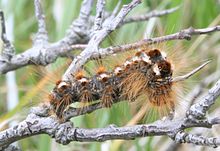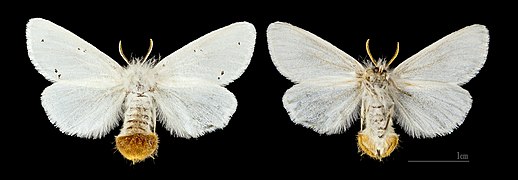Gold afters
| Gold afters | ||||||||||||
|---|---|---|---|---|---|---|---|---|---|---|---|---|

Goldafter ( Euproctis chrysorrhoea ) |
||||||||||||
| Systematics | ||||||||||||
|
||||||||||||
| Scientific name | ||||||||||||
| Euproctis chrysorrhoea | ||||||||||||
| ( Linnaeus , 1758) |
The Goldafter ( Euproctis chrysorrhoea ) is a butterfly ( moth ) from the subfamily of the bearer moth (Lymantriinae) within the Erebidae family.
features
The gold afters reach a wingspan of about 30 to 35 millimeters and is therefore significantly larger than the swan ( Euproctis similis ), which is similar to it . The best way to distinguish the two carrier moths is the extent of the yellow area on the abdomen (anal bush). The males have a rust-red end on the abdomen, while the females show a wider rust-colored area. Some individuals also have yellow-brown bristles on their abdomen. The top of both pairs of wings is white without the black spot that the swan has.
Similar species
- Swan ( Euproctis similis )
- American weaver ( Hyphantria cunea )
- Narrow-winged spotted body ( Spilosoma urticae )
distribution
You can find this species all over Europe , in the north to central Sweden and southern Finland . Furthermore in the south-western Mediterranean area, on the Iberian Peninsula and to Russia in the east. The species was introduced into North America about 100 years ago.
habitat
The most important biotopes today are parks and orchards. In the past, light mixed deciduous forests were the home of the gold afer.
Way of life
The female lays around 200 eggs in a heap and then spreads the hair of her abdomen over them to protect them from predators. The clutch now looks like a tree sponge and is therefore not immediately discovered by birds .
The caterpillars are found from September to June and remain together for a while directly after hatching. In summer they weave leaves together with a 8 to 10 centimeter large, white, felt-like web. Even after hatching in the spring, the animals keep coming back to this web after they have eaten. When eating, this type secretes filaments.
The caterpillars are about 35 to 40 millimeters long, gray-black in color, provided with a red and white pattern and have long hairs. They mostly feed on hardwoods such as oak , cherry , plum , apple and pear trees .
The caterpillars hibernate gregariously in a winter nest.
Flight times
The animals fly from late June to early August.
Harmful effect
The species prefers trees and bushes in the open landscape, avenue trees , solitary trees and fruit trees in gardens and orchards . Often it comes to the bald eaten, so that the gold after is considered a pest . It can be combated by separating the hibernating webs after the leaves have fallen or by spraying the leaves with Bacillus thuringiensis preparations or neem preparations in the young caterpillar stage before the webs are densely spun.
literature
- Günter Ebert (Ed.): The Butterflies of Baden-Württemberg Volume 4, Moths II (Bombycidae, Endromidae, Lemoniidae, Saturniidae, Sphingidae, Drepanidae, Notodontidae, Dilobidae, Lymantriidae, Ctenuchidae, Nolidae). Ulmer Verlag Stuttgart 1994. ISBN 3-8001-3474-8
- Karl Cleve: "The gold after (Euproctis chrysorrhoea L.) as a sea buckthorn pest", annual report of the Research Center for Island and Coastal Protection, Vol. XIII, 1972.
Web links
- Lepiforum e. V. Taxonomy and Photos
- www.schmetterling-raupe.de
- Moths and Butterflies of Europe and North Africa (English)
- Collection of the Natural History Museum Stockholm (Swedish)
- Euproctis chrysorrhoea in Fauna Europaea
- waldwissen.net : "Lovely" caterpillars
Individual evidence
- ^ J. Donald Lafontaine, Michael Fibiger: Revised higher classification of the Noctuoidea (Lepidoptera) . In: The Canadian Entomologist . tape 138 , no. 5 , October 2006, ISSN 0008-347X , p. 610-635 , doi : 10.4039 / n06-012 .




